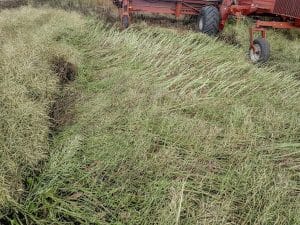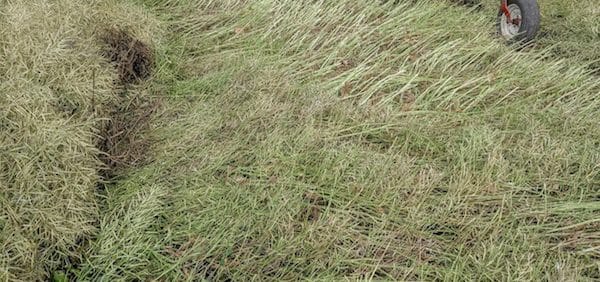When choosing canola hybrids for 2018, think through the yield, quality and profit achieved over the past few years and consider what factors may have reduced overall profitability. Add notes on harvestability. Then consider how seed traits could help manage any existing and potential challenges, reduce risk and improve profitability.

Seed traits to consider:
Disease resistance. Disease can be a major yield-robber and finding a disease resistance package that matches the situation on the farm can go a long way to improve yields and profitability. An important consideration: Is seed the best way to manage the disease in question? Genetic resistance is one effective tool to manage clubroot and blackleg in fields with those diseases. Note that all varieties on the market are resistant (R) or moderately resistant (MR) for blackleg, but not all varieties have a source of clubroot resistance. For blackleg in particular, growers now have tests to identify the blackleg races present in a field. They can use this information to choose varieties with resistance to those races. For clubroot, genetic resistance deployed before clubroot arrives in a field (or before symptoms are evident) is a good tool to keep spore loads low. Read more on clubroot and seed. Read more on R-gene rotation for blackleg.
Herbicide tolerance (HT) package. Some farms have rotations or minimum tillage systems that favour specific HT system choices. But is sticking with one HT system hurting profitability in other ways? Consider a few different scenarios to test the current approach. For example, do you have any herbicide-resistant weeds to manage? Are you looking for better canola volunteer control that rotating systems might offer?
Maturity. Is canola harvest always late on your farm? Was it delayed this year? If this adds too much stress to the harvest season, earlier maturity might be a high priority. Note that higher seeding rates and seeding in early May (when possible) are other steps that can bring in the harvest earlier.
Lodging resistance. A variety with top-level standability might end up yielding more and reducing harvest stress on your farm compared to a variety with higher yield potential but less lodging resistance.
Pod shatter tolerance. If straight combining is part of your system, this trait has proven yield benefits – especially if combining is delayed for any reason. Research has shown while any variety can be straight combined in ideal conditions, pod shatter tolerant hybrids will outperform the others in variable straight-combining conditions. Canola Performance Trials 2017 results will include a comparison of pod shatter tolerance traits.
Yield. Yield potential is obviously very important to profit, but growers cannot realize the last few percentage points of yield from a variety if it’s not well matched to the conditions and farming systems. One approach is to consider first which of the above traits are needed to improve quality, harvestability and disease management, and to match the weed and harvest programs on the farm. From the short list of varieties that meet these needs, pick the one that has the highest yield potential.
Seed cost. Seed with stacked traits tend to cost more per pound. Seed cost is a factor in profitability calculations.
Seed treatment. While not a seed trait per se, choice of seed treatment can influence stand establishment in certain higher-risk scenarios. For example, if a farm is particularly prone to heavy cutworm feeding on seedlings or if canola is going into a higher risk cutworm situation (lots of flowering fall weeds, pulses the year before), investing in a seed treatment with cyantraniliprole (Fortenza, Lumiderm) may pay off. These treatments as well as sulfoxaflor (Visivio) can also improve protection from striped flea beetles. With flea beetles, one option – if the new seed treatments don’t make sense across the whole field – is to use the new seed treatments on seed planted around the headlands only, where flea beetle feeding tends to be higher. An agronomy note on new seed treatments: Scouting is still required; canola under pressure from cutworms and flea beetles may still need to be sprayed.
A few scenarios:
Clubroot is in the area. When the disease is confirmed in your community, it will reach your farm eventually (if it hasn’t already). So even if clubroot resistant (CR) hybrids didn’t seem worthwhile in the past, the trait will provide an economic benefit if it keeps the disease at low levels for the long term. The CR trait and the yield benefits it provides will be a top priority in seed decisions on many farms.
Clubroot resistance versus yield. Sometimes the variety with the highest published yield is a clubroot-susceptible variety. Consider the risk of an undetected low level of clubroot increasing to yield-robbing levels if you use a susceptible variety. Is yield potential alone enough? The good news is that many of the new CR varieties have no yield penalty, so choosing a CR variety for yield and clubroot risk mitigation is a win-win scenario.
Clubroot resistance versus straight-cut performance. Farmers can get pod shatter tolerance and clubroot resistance in the same hybrids now, but if the choice comes down to one or the other for economic and other reasons, when should you give up on pod shatter and go with clubroot resistance? With clubroot confirmed in more regions each year, CR will be the higher priority for many growers.
Blackleg is getting worse. Blackleg-resistant seed has been the top blackleg management tool. But if blackleg seems to be getting worse, rotating to a different source of blackleg resistance should have yield and profit benefits. By scouting for blackleg each harvest season, you can track when this disease becomes an issue.
Herbicide tolerance (HT) versus blackleg resistance. If blackleg seems to be getting worse but rotating to a different source of blackleg resistance is difficult under the desired HT system, the grower could ask their preferred seed company for options from a different blackleg resistance gene group, take other approaches such as longer rotations, or change the farm cropping plan to work in a different HT system.
Lodging options. Is improved genetic resistance to lodging the best approach for yield and profitability? It could be if other measures, such as lower seeding rates and lower amounts of nitrogen, are less desirable from yield, disease management and harvestability perspectives.
Further reading:
New Canola Variety Selection Guide: Featuring CPT Summary Data
Variety comparisons at canolaperformancetrials.ca
Improvement to blackleg resistance labeling
How much seed to buy?

